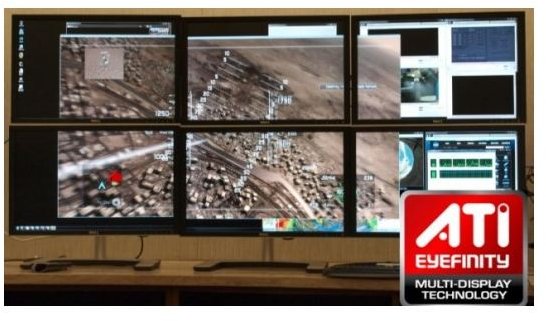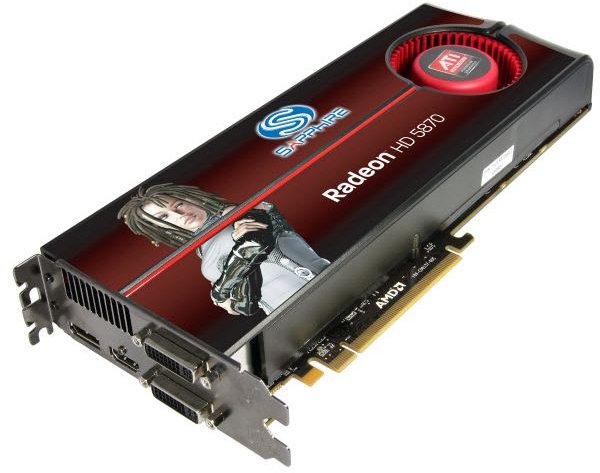Radeon 5870 Specs Explained: ATI's Best Graphics Card
AMD Conquers the High End
The Radeon 4000 series video cards proved that it was no longer necessary to spend even $200 dollars to purchase a graphics card adequate for playing any PC game available today. The 4850 is now available for under $100 dollars, and the 4870 can be purchased for as little as $125. Yet as good as these cards are, those looking at high-end products were still often best with Nvidia, The GTX 260 was an amazing performance value when paired together in SLI, and the GTX 285 was the fastest single-GPU card available.
However, AMD has now unleashed the Radeon 5870 and Radeon 5850 and aimed them directly at Nvidia’s best products. The reviews are clear - ATI has done it again. The Radeon 5870 is the fastest single GPU card today, and the Radeon 5850 isn’t far behind. But how are these cards different from the Radeon 4000 series products, and should you upgrade?
Seeing Double
At a distance, the GPU which powers the 5870 and 5850 looks very much like two RV770 GPUs placed together in a single package. The GPU from a Radeon 5870 has double the number of SIMD arrays, double the number of texture units, two rastierzers, and so on. In laymen terms this means that the theoretical horsepower of the Radeon 5870 is double that of the Radeon 4870.
That isn’t to say that ATI has been lazy and simply made the new RV870 GPU a double-sized reproduction of the RV770. Other tweaks have been made to the new GPU which result in better image quality than any video card previously available. For example, the Radeon 5870/5850, and indeed all Radeon 5000 series products, use a new anisotropic filtering algorithm which allows the new graphics cards to render colors more accurately.
Smaller is the New Bigger
Despite the performance increases, the Radeon 5000 series GPUs are still quite small. This is thanks to the use of the new 40nm manufacturing process. Die-shrinks of this kind generally result in not only lower costs to the manufacturer, but also parts which consume less energy and produce less heat. ATI has also tweaked the architecture to allow for better power management.
The results are quite astounding. A system with an Intel quad core processor and a Radeon 5870 will consume only 120 watts of power at Idle and about 300 watts of power at load. For reference, that is less than a system equipped with a Radeon 4890. It is also less than a system equipped with a Nvidia GTX 285. As a result of this low energy consumption, the Radeon 5870 also produces no more heat than a Radeon 4890.
Features Ahoy!
Performance is only part of what is on offer with the Radeon 5000 series products, however. It is becoming increasingly obvious that graphics card development is out-pacing the development of 3D graphics, which is making performance less relevant. ATI is responding by offering a buffet of features.
The most important is full support of DirectX 11. DirectX 11 is only used in a limited number of games currently, but it offers numerous new features which future games will likely incorporate. ATI has also enabled the use of supersampling. Supersampling is a method of antialiasing which samples every pixel in an image multiple times. This is superior to current antialiasing technology, which only samples those areas in an image which correlate with the edge of a polygon. Supersampling offers superior picture quality, but it is also much more demanding on a GPU. Its inclusion is a smart one, as it allows those who are playing older games which already run well a tangible reason to upgrade to a Radeon 5000 series card.
Lastly, there is Eyefinity. Eyefinity is a new technology from ATI which allows a game to be played on multiple monitors. For example, three monitors in a row would greatly extend the field of vision of the player to both the right and left. Placing six displays together would allow for a super-sized screen. While Eyefinity is mostly a publicity stunt - most gamers don’t just have 6 screens laying around, nevermind a way of mounting them together - it is an interesting feature to play with.
Should You Buy a Radeon 5000 Series Card?

If you have a Radeon 4000 series card, the answer is likely no, at least for a time being. The Radeon 5000 series is fabulous, and the new features like supersampling are quite good, but the Radeon 4000 series cards were already more than adequate for most games. While a Radeon 5870 is much faster than a Radeon 4870 in benchmarks, the eye can’t register differences in frame rate above a certain point. As a result, buying a new card can’t be recommended.
If you have an older card, however, the Radeon 5000 series is a good choice. While the older Radeon 4000 series cards are currently much cheaper, I think that the features added to the 5000 series are worth spending the extra money. And if cash is the issue, then just wait a few months. The 5000 series just recently launched, which means availability is still limited and demand is higher than supply. Production volume will go up over time, and the Holiday season will certainly cause retailers to offer great deals on these cutting-edge cards.
